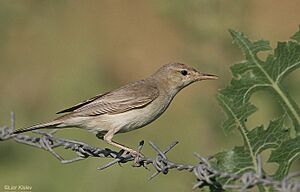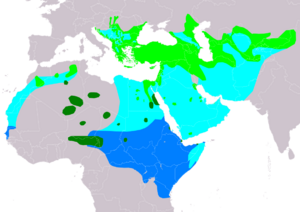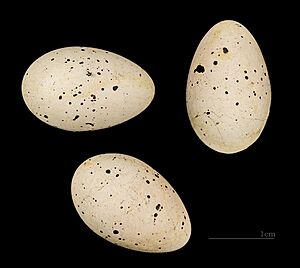Eastern olivaceous warbler facts for kids
Quick facts for kids Eastern olivaceous warbler |
|
|---|---|
 |
|
| Conservation status | |
| Scientific classification | |
| Genus: |
Iduna
|
| Species: |
pallida
|
| Subspecies | |
|
|
 |
|
| Range of I. pallida Breeding Resident Passage Non-breeding | |
| Synonyms | |
|
Hippolais pallida (Ehrenberg, 1833) |
|
The eastern olivaceous warbler (Iduna pallida) is a small bird. It's sometimes just called the olivaceous warbler. This bird lives in the Old World, which includes Europe, Asia, and Africa. It breeds in places like southeastern Europe and the Middle East. When winter comes, it flies south to warmer parts of Africa.
Contents
What Kind of Bird Is It?
The eastern olivaceous warbler is a type of bird called a 'warbler'. It belongs to a group known as the Acrocephalidae family. This family includes birds like reed warblers and tree warblers. Its scientific name is Iduna pallida.
For a long time, this bird was thought to be the same species as the western olivaceous warbler. But now, scientists usually consider them two different species.
What Does Its Name Mean?
The scientific name Iduna pallida has a special meaning. The word pallida comes from Latin. It means "pale" or "light-colored". This name fits the bird's light brown feathers.
Where Does It Live?
This small bird likes dry, open areas. You can find it in places with bushes or a few trees. This includes farmland and gardens.
Bird Migration
The eastern olivaceous warbler is a migratory bird. This means it travels long distances each year. It spends its summers breeding in southeastern Europe and parts of Asia. When winter arrives, it flies south. It spends the colder months in sub-Saharan Africa or the Arabian Peninsula. Sometimes, a few lost birds might show up in northern Europe.
What Does It Eat?
Like most warblers, the eastern olivaceous warbler mainly eats insects. It helps control insect populations in its habitat.
How Does It Breed?
Eastern olivaceous warblers build their nests low down. They often choose a bush or thick undergrowth. The female bird usually lays two or three eggs. These birds breed in southeastern Europe, the Middle East, and western Asia. Some are also found breeding in southeast Morocco.
What Does It Look Like?
The eastern olivaceous warbler is a medium-sized warbler. It has a plain, pale brown back and whitish feathers on its belly. Its beak is strong and pointed, and its legs are grey.
Both male and female birds look the same. Young birds might have a slightly more buff color on their bellies. A fun way to spot this bird is by its tail. It often flicks its tail downwards.
How to Tell It Apart
It can be tricky to tell the eastern olivaceous warbler apart from other similar birds.
- The western olivaceous warbler is usually bigger. It also has a browner color on its back and a larger beak.
- The eastern olivaceous warbler sometimes has a greenish tint to its upper parts. This can make it look very similar to Sykes's warbler.
The eastern olivaceous warbler has a unique song. It's a fast, babbling sound that can sound a bit nasal.



